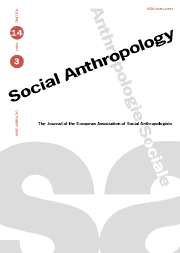Auspicious Hindu houses. The new middle classes in Hyderabad, India
Published online by Cambridge University Press: 02 December 2003
Abstract
This essay argues that the Hindu notion of auspiciousness, adherence to propitious timings, inauguration ceremonies and other practices that are conducive for success in future dealings has become pivotal for the definitions of Hindu middle-classness in India. First the concept of auspiciousness and the debate that ranged in relation to it in the 1980s and early 1990s is reviewed. Then, some ethnographic sketches of housing among Hyderabadi new middle-class Hindus are presented. In social practice centred around auspiciousness, Hindus who identify themselves as middle class find a way of creating social value and respectfulness which does not derive directly from the hegemonic notions of hierarchy, purity and caste. While not rejecting the principles of hierarchical social relations, new middle-class Hindus remodel notions of social honour from within by stressing auspiciousness instead of purity.
- Type
- Research Article
- Information
- Copyright
- © 2003 European Association of Social Anthropologists
Footnotes
- 7
- Cited by




